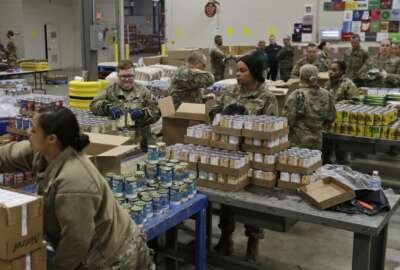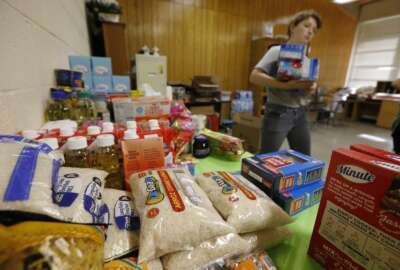
Feds continue being charitable during pandemic
A month into the annual Feds Feed Families food drive, we decided to check back in with its national chair.
Best listening experience is on Chrome, Firefox or Safari. Subscribe to Federal Drive’s daily audio interviews on Apple Podcasts or PodcastOne.
A month into the annual Feds Feed Families food drive, we decided to check back in with its national chair. She works on this vital program in between doing her day job at the Agriculture Department. Vinnie Panizo joined Federal Drive with Tom Temin.
Interview transcript:
Tom Temin: Vinnie, good to have you back.
Lavinia Panizo: Wonderful. Thanks Tom for having me.
Tom Temin: And it has been a difficult month because no one knows from hour to hour which way the COVID situation is going up, down or sideways — and so give us a progress report on how the donations and food coming in is going.
Lavinia Panizo: Well, I’m happy to report that federal employees have been very hard at work and very generous in their giving and we currently have 2,300,000 pounds of food donated. That’s about 2000 employees participating in fed feeds families, and they’ve been giving in all sorts of ways — and we’re just thrilled.
Tom Temin: Yeah, so that’s a ton per employee basically, or half a ton per employee.
Lavinia Panizo: Well, and some of those donations might be by group effort. So there’s a variety of ways that the donations are recorded. So individuals, group efforts, a family can go in glean and they can record that as well.
Tom Temin: And has that actually happened? Do you have like pictures or anecdotes or reports coming in of people going out and doing physical work like that, such as gleaning a field or cleaning up after a food market?
Lavinia Panizo: Absolutely, yes, absolutely. Gleaning is a very popular activity. And we’re actually really moving into gleaning season right now. And that’s where people go to farms and they will collect the produce that hasn’t been harvested. So the farmers may have already collected the produce, but then there’s additional remnants that are remaining that are just as good as anything, and people will volunteer to collect that. In addition, one of the really neat things that I learned a lot about yesterday is that people can garden at home, they can either plant an extra row or a lot of gardeners will have excess produce that they can then donate to food pantries. And this actually does two things. One, it obviously brings healthy nutritious food to people in need, ut it also helps to reduce food waste, because the number of gardeners is growing exponentially because everyone’s at home now. And any of that excess produce can now be used to give to people in need through your local food pantry and you can find that online, your pantry closest to you and you’re also helping to reduce food waste by not letting any of that produce go to waste.
Tom Temin: Sure. And do you have any sense of the geography of where this gleaning is taking place? I mean, you think of farming, you think of the midwest, but in fact, there’s farms in every state. Do you have any sense of the geography?
Lavinia Panizo: Gleaning takes place everywhere. I know for sure that we’ve had organizations in Virginia reach out to us and I’ve worked extensively in the southwest and I know that it happens there as well. So really anywhere in the country where produce is being grown, you’ll be able to find somewhere to glean. There are a lot of resources online for that.
Tom Temin: In Rockville, one of my running routes goes past this large area operated by the city where people can rent plots in a big field. And I think they’re 20 feet by 10 feet or something all fenced off. And that place is going gangbusters this summer. So maybe there’s a lot of this kind of home gardening being done for this purpose.
Lavinia Panizo: Absolutely. Part of the planter row or gleaning can take place anywhere. It can take place in community gardens, like anywhere that you can find that unwanted or unused produce. I used to live in Los Angeles in California, and we would have lemon trees and avocado trees just in the parking lot. So that’s fresh produce that I ate and certainly you could collect.
Tom Temin: Aside from gleaning, there are other ways people are giving. What are you seeing in the trends of how this 2.3 million pounds so far is coming in besides physically in bushel baskets?
Lavinia Panizo: Well, CFC ran a special solicitation for the month of May and June. And I’m sure that was a big contributing factor to this. So what employees did was they gave to their local food bank or food pantry through CFC, and then they were able to record that donation that they had made to CFC on the hub — and I’m sure that that’s been a big contributor to our numbers.
Tom Temin: And by the way, you have a future collaboration with the CFC also?
Lavinia Panizo: Yes, so during the CFC campaign, which typically takes place sometime between September and January, if employees give to food based or food pantries through CFC, they can also still record that donation to the Feds Feeds Family hub and make it a twofer, a two for one of giving.
Tom Temin: Sure. And what are the other means? There are monetary contributions, and then there are people can bring physical food to food banks. So there’s a couple of ways you can do that.
Lavinia Panizo: Yes. So other things that people have done is we have a lot of volunteer coordinators for Feds Feed Families, whether they’re chairs or champions. And what they’ve been doing is they’ve been putting together virtual food drive events for employees to attend to help them learn about what the opportunities are in their communities. So this can happen anywhere in the country. And we actually had when we had our launch event, but we also had one earlier this week for the National Capital Region, where organizations were invited to come and talk about their needs and what people could do to help them. Other things you can do our warehouse glean, you can go and sort and package food donations for distribution, you can help distribute the food donation, you can just kind of help with whatever they need. Even just volunteering your time to a food bank or food pantry, even if it doesn’t necessarily include handling food that can also be counted towards Feds Feeds Families. But the virtual food drives are great because it’s a great way to bring people together around this issue, and then to learn about what the needs are and what the opportunities are to give in your community.
Tom Temin: And we should point out that the website you have this year is really amazing with all the buttons where you can record your donation, and I’m looking at the recently recorded donations. Folks, you got to read this, and it’s a page of the CIO of the Agriculture Department. But here’s one little factoid, the Department of Agriculture itself, the Food Safety and Inspection Service, just donated 1,872 pounds just a few days ago.
Lavinia Panizo: That is so awesome. That is like one of the funnest tools we have and it’s a really powerful tool that we have on the Feds Feed Families hub so I appreciate you bringing that up. What you can do on the hub is you can actually filter in a lot of different ways. So if you want to see how much feds have donated in a state, you can pull up a filter and see how much feds have donated, let’s say, in the state of Washington, or in Virginia, or in Texas or Arizona, wherever you want to see. You can also filter through agency or department. So if you want to see how much say the Department of Commerce employees have been able to contribute in terms of pounds, you can do a filter for that you can look at what’s been donated this week or last week or the overall campaign, which we’ve actually allowed employees to record any of their giving for the entire 2020 calendar year. I know that people have been really moved with what they may have seen on television and what families are going through around the country and that they’ve been doing things in their communities so we’re encouraging them that even if they did it before the campaign was launched that they can still go on the hub record what they did back in March or April and record that and let it be be displayed to show like how much federal employees care and are doing to alleviate hunger.
Tom Temin: And I guess it can almost get competitive and maybe I’ll foster that a little bit. Okay, you folks at food Safety and Inspection Service, the Department of Energy, management at the Energy Department. There’s a donation here just a few days ago, about a week and a half ago 3,600 pounds. So the race is on.
Lavinia Panizo: Well folks can use can use the hub however they decide to use it, but we really focus on celebrating all federal employees in their donations. We want the race to be against hunger, and to focus on the overall impact of what we’re able to do together and collectively, but I’m sure people are having a lot of fun with this too.
Tom Temin: (Jokingly) Spoken like a true national chairman. Vinnie Panizo is national chair of the Feds Feeds Families campaign. And by the way, when does the whole thing wrap up?
Lavinia Panizo: So the campaign ends this month. However, like I said earlier, we’re allowing employees to record their donations throughout 2020. And gleaning really starts to ramp up this month and next month is when a lot of produce comes to harvest. So that’s when folks will go out and do that and they can continue their giving year round and record those donations to the hub.
Tom Temin: Vinnie, thanks so much for joining me.
Lavinia Panizo: Thank you Tom. It was a pleasure to come back again.
Check out the Feds Feed Families dashboard here.
Copyright © 2025 Federal News Network. All rights reserved. This website is not intended for users located within the European Economic Area.
Tom Temin is host of the Federal Drive and has been providing insight on federal technology and management issues for more than 30 years.
Follow @tteminWFED





